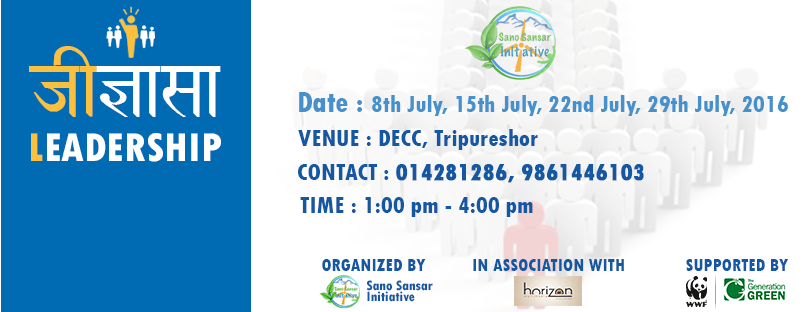After successfully completing Jigyasha: Leadership show, we…
Mr. Aryal elected for president of Plant for the Planet Global Youth Board
 The Plant-for-the-Planet, Initiative was founded in January 2007. It has its origin in a school presentation about the climate crisis of the – back then – 9-year-old Felix Finkbeiner. Inspired by Wangari Maathai, who planted 30 million trees in africa, Felix developed at the end of his presentation the vision that children could plant one million trees in each country of the world to create a CO2 balance therewith. During the following years Plant-for-the-Planet developed to a worldwide move: At present approx. 100,000 children in over 100 countries pursue this goal. They understand themselves as an initiative of world citizens which campaign for climate justice in the sense of total reduction of the emission of greenhouse gases and an homogeneous distribution of those emissions among all humans.
The Plant-for-the-Planet, Initiative was founded in January 2007. It has its origin in a school presentation about the climate crisis of the – back then – 9-year-old Felix Finkbeiner. Inspired by Wangari Maathai, who planted 30 million trees in africa, Felix developed at the end of his presentation the vision that children could plant one million trees in each country of the world to create a CO2 balance therewith. During the following years Plant-for-the-Planet developed to a worldwide move: At present approx. 100,000 children in over 100 countries pursue this goal. They understand themselves as an initiative of world citizens which campaign for climate justice in the sense of total reduction of the emission of greenhouse gases and an homogeneous distribution of those emissions among all humans.
Sagar Aryal, Founder of Sano Sansar Initiative was elected as the Global Board President of Plant for the Planet for 2012/13. He will be starting his term from July 2012 to continue the support the following 3-point agendas of Plant for the Planet.
1. Put carbon in the museum.
We absolutely need to get our CO2 emissions levels down to zero by 2050. The technology for such a CO2-free future already exists. With today’s engineering capabilities we can easily make the transition to 100% renewable energy (without the need for nuclear power) by 2050.
2. Poverty into the museum through climate justice.
To restrict the future warming to just 2∞C, which was promised by the heads of the governments in Copenhagen, only 600 billion tons of CO2 can be released until 2050. If we produce more CO2 than this the temperature will also increase more than 2∞C. If the average temperature increases by more than 2∞C there is a chance that the ice in Greenland could melt completely. This would mean that the mean sea Level would rise by 7 metres. If we divide 600 billion tons of CO2 by 40 years this allows 15 billion tons of CO2 per year. In 2010 31 billion tons of CO2 was produced. The next question we face is how we can divide these 15 billion tons of CO2 fairly across the world’s population? Should it continue like it is today with the USA and Europe producing more than 60 percent just by themselves? For us children and youth there is only one solution: everybody gets the same, meaning 1.5 tons of CO2 per person per year, estimating a population increase to 9 to 10 billion people by 2050.
But how does this help to solve the problem of global poverty? On average an American citizen emits around 20 tons of CO2 per year and a European citizen emits around 9 tons. In comparison, people in Africa emit on average only 0.25 tonnes per year. Our proposal: The people in the rich countries, who want to emit more CO2, must buy the rights from those who emit less. This is our principle for climate justice. With the money that the people in the poorer countries earn they can then invest in agriculture, education, health and more. They will also have an incentive to invest in renewable energy technologies so that they can maintain the right to sell their CO2 emission allowance. This will also stop them from making the same senseless mistakes that we in the west have.
Perhaps 2∞C doesn’t sound like much, but this would mean significant changes for us children and youth. Exactly what would change is for now unsure. One thing we do know however is that years ago when the temperature was 5∞C lower than today, there was a layer of ice, two kilometres thick across most of Europe. Even if we remain below 600 billion tons of CO2 output until 2050 it is only 75% certain that the average temperature rise will remain below 2∞C. No one knows exactly what is going to happen.
3. Planting 1,000 billion trees.
We want to protect the existing woods and we want to plant billions of new trees. Altogether 1,000 billion new trees. There is still one billion hectares of free space on our earth where 1,000 billion trees could be planted. These trees would absorb an additional 10 billion tons of CO2 every year. 1,000 billion trees sounds like a huge amount, but it is possible. The Chinese alone planted 2.7 billion trees in 2009 as a contribution to the UNEP-Billion Tree Campaign. If everybody plants 150 trees in the next ten years we will reach 1,000 billion trees by 2020. By working together we can definitely achieve this. It isn’t that hard and it is not impossible anymore.
Of course we know that we can’t stop climate change just by planting trees. But by planting 1,000 billion trees in the next 10 years this will help to absorb more CO2 and give us a kind of ëtime-joker’ or buffer so that we have a bit more time to get our act together and really start reducing our carbon emissions. Considering that from 2009 to 2010 we actually increased emissions by 5%, instead of decreasing them, it is clear that we still have a lot to do. If we continue to increase our carbon emissions by 5% every year we will have used up our 600 tonne budget, and caused the climate to rise by 2C, by 2024. Alternatively if we continue with the same rate of emissions as in 2010, we will have hit the 600 billion tonne mark by 2029. These statistics are highly concerning and this is why we also consider each tree that we plant to be a symbolic action sending a on clear message that we need to take action against climate change today.
While Plant-for-the-Planet is essentially a children and youth’s initiative we know that we will need some help from the adults if we are going to achieve our goals. This is why we have sent our ì3-point-planî to the heads of governments all around the world.
Sano Sansar team would like to congratulate and wish him for his success in upcoming days.




